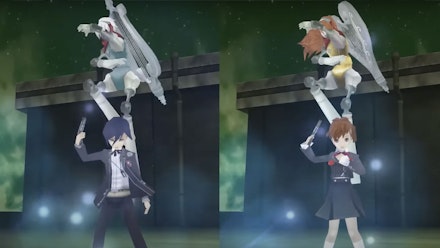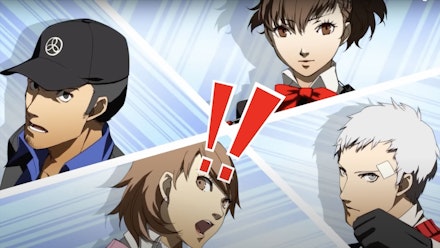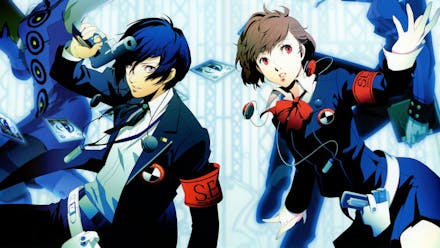Platforms: Nintendo Switch, PS4, Xbox Series X|S, Xbox One, PC
The history of Atlus’ Persona series of JRPGs is an interesting one – spinning off from the wider Megami Tensei_franchise with _Revelations: Persona on the PS1 back in 1996, Persona is now better known and more popular than its parent series. It’s been a long road to get there though, and while the likes of Persona 5 Royal are now considered exemplars of the genre, earlier entries that helped build that reputation have become harder for modern players to experience.
That’s part of what makes this re-release of 2006’s Persona 3 Portable such an interesting time capsule. While Atlus has also reissued modern ports of successor – and fan favourite – Persona 4 Golden alongside this, the sequel having already been released on PC back in 2020 meant it was readily available. In contrast, Persona 3 has long been unplayable: if you lacked the physical PS2 or PSP versions, released well over a decade ago, you were out of luck – until now.
That unavailability was a real shame, since as both a JRPG in its own right, and a formative instalment in the powerhouse series that Persona has since become, Persona 3 Portable remains (mostly) a delight. Like much of the series, it’s a blend of slice-of-life relationship management and genre-typical dungeon crawling, but it’s also the entry where so many familiar mechanics from later Persona games really crystallised. For one thing, Persona 3 Portable abandoned the grid-based battles of its immediate predecessor, favouring a more dynamic visual approach to turn-based combat.

It's also where the series began locking in some of the bold aesthetic and stylistic choices, even at the game menu level, that Persona 4 and 5 would later refine. There’s even some imagery that retains the ability to shock all these years later, notably the sight of its largely teenaged cast shooting themselves in the head to draw out the power of their Persona, the eponymous demons drawn from their own psyches and based on Tarot arcana. Persona 3 may not be the first Persona game, but it’s the one that set the course for the ones that followed.
The plot sees the protagonist – canonically named Makoto Yuki in most adaptations, but left to the player to name here – moving to the city of Iwatodai for a new student life at Gekkoukan High School. Forget the usual travails of transferring to a new school though – instead, you’re drawn into a twisted otherworld known as the Dark Hour, a brief window between each day that sees the real world warp into a nightmarish reflection, where most people slumber unknowingly in coffins while demonic Shadows stalk those few who are aware of the change. As one such lucky person, you end up allying with the "Specialized Extracurricular Execution Squad," or SEES – a secret organisation consisting of, conveniently enough, several of your classmates, and the one group able to unravel the mystery of this alternate reality.
Persona 3’s combat wasn’t hugely revolutionary even back in 2006, and seems positively dated in 2023, but for fans of the genre it will at least feel comfortably nostalgic.
While there’s plenty of the relationship management and social activities that Persona is known for during each school day, often driving along key storyline developments or forging social links that in turn power up the protagonist’s abilities, uncovering the secrets of the Dark Hour mostly involves nightly excursions to Tartarus, the ever-shifting tower that takes the place of Gekkoukan during the Dark Hour – and it’s here where Persona 3 begins showing its age.
Each visit sees your party mapping out new areas – in itself, a fairly repetitive prospect, livened slightly by the ability to send party members off to scout out branching paths at the risk of encountering enemies solo – and edging ever further into Tartarus as you grow in power. Despite each visit offering a procedurally generated selection of floors to explore in an attempt to add some unpredictability, every trip feels functionally identical: clear out every Shadow enemy, grab loot chests, and defeat the occasional boss.

Battles against the Shadows themselves rely on the power of your Persona, and the powerful elemental the Persona can unleash. These factor heavily into the “one more” combat system – exploit a Shadow’s elemental weakness and you’ll stagger them and get to attack again; repeat this to stagger an entire group of enemies, and your whole party can leap in for a team attack that frequently wipes out foes in one hit. While this adds a unique touch to battles beyond the usual turn-based offerings of attacks, item usage, and defence, encounters can still feel rote. Persona 3’s combat wasn’t hugely revolutionary even back in 2006, and seems positively dated in 2023, but for fans of the genre it will at least feel comfortably nostalgic.
While Persona 3 Portable’s long-form investigation into Tartarus and the Dark Hour does fall into a routine of daytime social activities and nighttime battles, it remains one that’s strangely satisfying despite its more aged aspects. The rhythm works particularly well on Nintendo Switch (version tested), which replicates the portability of the original PSP release, lending itself to chunks of intermittent play.
Yet Atlus’ choice to base this modern port on the PSP version is also one of the biggest problems when it comes to playing Persona 3 in 2023. Beyond carrying over most of the dated visuals and low-poly 3D character models, getting the game running on Sony’s handheld back in 2010 meant stripping back resource-heavy elements. The most obvious impact of this is that instead of manually exploring environments outside of Tartarus, as players did in the PS2 versions of the game, you’ll move a cursor around static screens to interact with objects, more like a point-and-click adventure. It’s a change retained here, even though present day hardware doesn’t have the same limitations as the PSP.
Similarly, there’s a host of (arguably) absent content. Back on the PS2, the original Persona 3 saw an expanded release as Persona 3 FES, which added a lengthy new epilogue chapter. That was missing from the PSP release and so is absent here. However, we do get the Portable-original addition of a playable female protagonist, playing as whom can change some elements of the story, and new difficulty levels.
In an ideal world, Atlus would have given Persona 3 a full remaster to bring it out of retirement, combining the full environmental movement and new story material from FES with the female protagonist, branching story elements, and additional difficulty levels of Portable into one definitive edition. It's perhaps churlish to lament what the game isn’t though, when what it is remains an important entry in a beloved series. Its age and lacklustre presentation may make it more suited to dedicated Persona fans or completionists, but it if nothing else, it’s a delight that they can once again easily experience the game.
